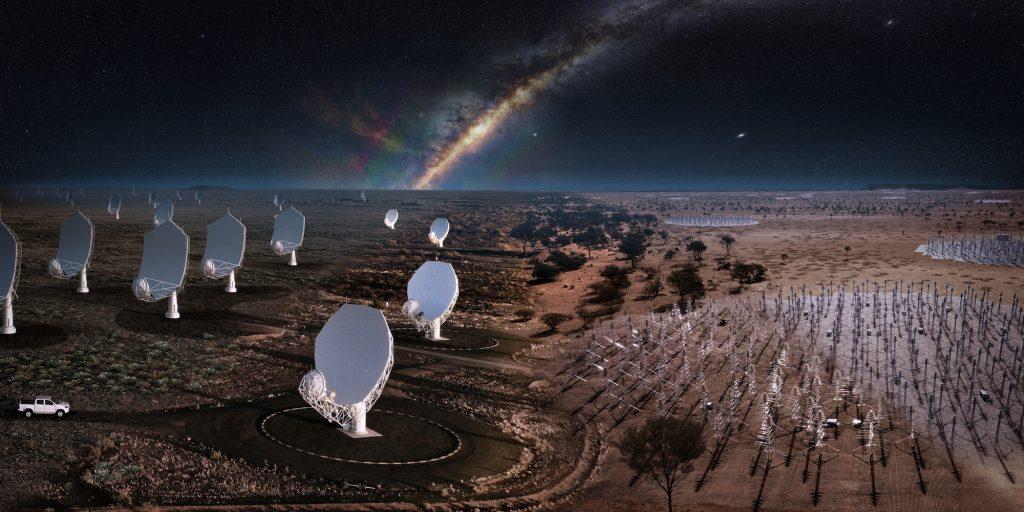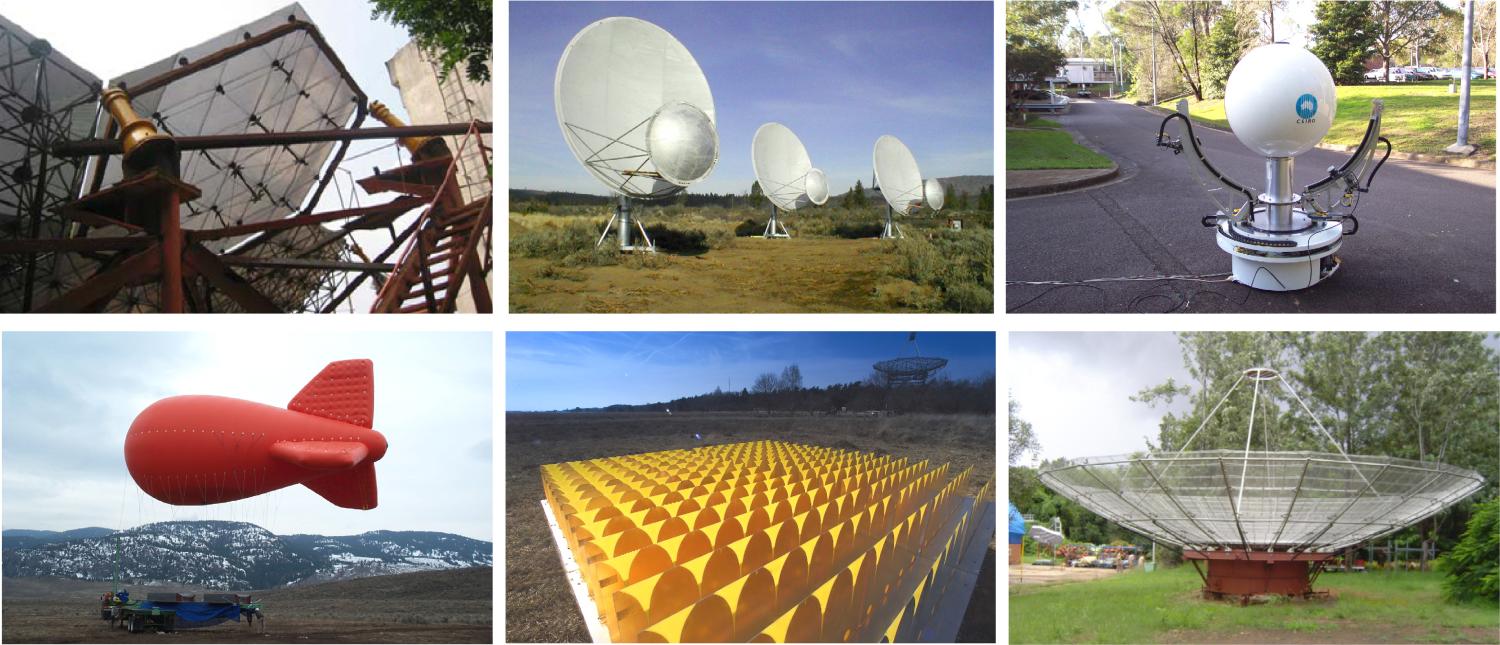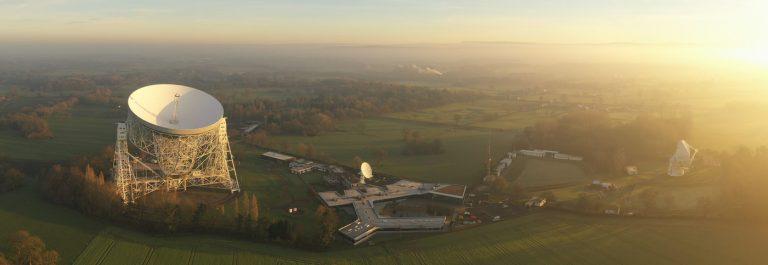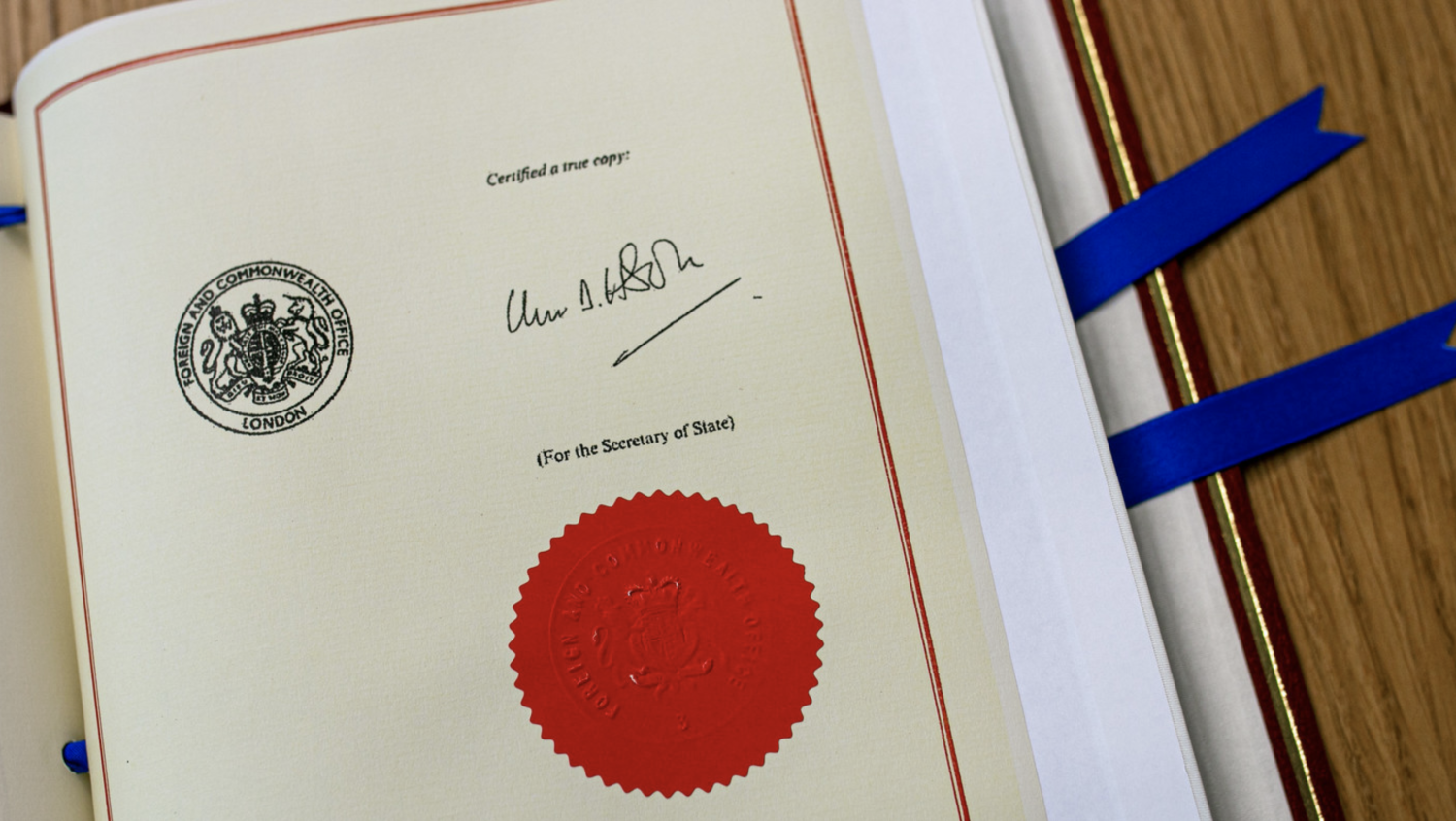History of the SKA project

The SKA project has been in the making for around three decades. Back in the late 1980s, astronomers from a number of countries converged their thinking around the desire to answer a simple question: How can we fill in the gaps in our understanding of the Universe by reading its history as written in the language of its most abundant constituent, Hydrogen?
To answer this question, we would need to be able to see back to the Cosmic Dawn, when the very first stars formed in a Universe that was only 100 million years old; to study the epoch of galaxy formation at 1 billion years of age; and to truly understand the current epoch of accelerating expansion, 13.7 billion years after the Big Bang, driven by the as yet unexplained force of Dark Energy.
What size of radio telescope would be needed to do this? The surprising answer is that any one of these tasks would independently require a telescope with a collecting area approaching one square kilometre (one million square metres). The SKA concept was born...
The drive to secure such a facility developed rapidly once it became clear that a radio telescope of this size would not only answer such fundamental questions about our cosmic origins and fate but would also enable a wealth of other discoveries to be made, in areas as diverse as the formation of Earth-like planets, detection of gravitational distortions of space-time, the origin of cosmic magnetic fields, and understanding the formation and growth of black Holes.
Over time, a continuous interaction between scientists and engineers led to the publication of a number of technical books and white papers and the development and refinement of key technologies, some of which were eventually adopted as part of the Reference Design and eventually the Baseline Design for the SKA telescopes. In 2005, a technology down-select process led to the short-listing of six potential technologies for the SKA and the production of a reference design document, which you can see below.

Through those years, the SKA has also slowly but surely cemented its place in policy circles and research roadmaps and a strong governance structure was put in place to drive the effort and coordinate the activities. Working groups and committees were created, agreements were signed to establish international collaborations and in the 2000s the telescope site selection process began, leading to the shortlisting of Australia with New Zealand and Southern Africa as potential host sites for the telescopes.
From 2010, things picked up, starting with the creation of the SKA Organisation in November 2011, with three clear objectives: to complete the site selection, to deliver the design of the SKA telescopes and to establish a solid governance structure. The SKA Office staff - at that time only 11 people - moved from their temporary offices on the University of Manchester campus to a new home, the current SKAO Global HQ site next door to the historic Jodrell Bank Observatory, just south of Manchester.
The following decade saw many milestones on the road to realising the SKA Organisation's objectives, from the dual site selection for the telescopes in South Africa and Australia in 2012, to the establishment of the international design consortia in 2013 and the subsequent design work by hundreds of engineers around the world.

In 2015, Jodrell Bank was selected as the permanent home of the SKA Observatory, leading to a major expansion of the SKAO’s Global Headquarters there. The SKAO science book, Advancing Astrophysics with the Square Kilometre Array, was published, an impressive two-volume book demonstrating the breadth of science to be eventually addressed by the SKA telescopes and containing 135 chapters written by 1,213 contributors from 31 nationalities.
On the policy front, international negotiations started in 2015 with the aim to establish the SKA Observatory as an inter-governmental organisation in order to tackle construction and operations of the telescopes. These negotiations progressed at an impressive pace, ending just four years later with the signing of the SKAO Convention in Rome on 12 March 2019.
Since then, things have accelerated even more. The extended SKAO Global HQ was inaugurated in July 2019 and later in the year, the final overall review of the telescopes’ design was passed in December 2019, followed by the completion of critical reviews to assess our construction and operations plan. We also received the endorsement from the SKA Organisation Board of Directors of two foundational documents of the Observatory, namely the Construction Proposal and the Observatory Establishment and Delivery Plan, marking the culmination of many years of work by experts within the office and around the world.


In parallel, ratifications of the treaty took place in signing countries, with the Netherlands, Italy, South Africa, Australia, Portugal and the UK completing their legislative processes to enshrine the SKAO Convention into law. This opened the door for the SKA Observatory to come into existence on 15 January 2021, with the official launch at the first meeting of the newly-formed SKAO Council on 3-4 February 2021.
June 2021 saw the biggest moment in the SKAO's history to date, when the Council formally gave the green light for the start of SKA construction activities. Procurement of major contracts began immediately, with 35 major contracts totally just shy of €134m awarded in the following nine months, mainly for software development. By the close of 2022, contracts worth some €500m will have been awarded as the SKAO continues to progress along its ambitious construction schedule.
The journey to the SKA Observatory
Why did the SKA project transition to become an intergovernmental organisation?
Few projects come close to the scope and ambition of the Square Kilometre Array (SKA) as a scientific endeavour. Alongside the talents of thousands of skilled professionals and the development of groundbreaking technology, the SKA requires a governance structure capable of delivering such a huge global project.
Geographically distributed between three host countries, and with more than a dozen member nations, the SKA project demands an extraordinary level of international cooperation. As it becomes a reality on the ground, facilitating the smooth movement of equipment, money and people across borders is essential.
This was the impetus behind transitioning the SKA Organisation – a private, non-profit company which has overseen the telescope design phase – into the SKA Observatory (SKAO), an intergovernmental organisation established through international treaty, similar to CERN and the European Space Agency. The Observatory is the legal entity responsible for constructing and operating the SKA telescopes in Australia and South Africa, with its headquarters in the United Kingdom.
This model was first proposed in October 2013, and two years later the formal negotiations began to draft the SKA Observatory Convention.
Establishing the SKA Observatory
After two and a half years of multilateral negotiations led by Italy, the text of the SKA Observatory Convention was agreed in May 2018 and signed on 12 March 2019 in the Italian capital, Rome. Seven countries became the initial signatories to the Convention: Australia, China, Italy, the Netherlands, Portugal, South Africa and the United Kingdom.
Ratification and entry into force
As the depository of the SKA Observatory Convention, the United Kingdom’s Foreign, Commonwealth and Development Office (FCDO) oversaw the formal process of ratification and entry into force. This includes holding the original signed Convention in its vault in London, and creating certified true copies for each signatory state, which were distributed in March 2019.
The treaty ratification process varies by country, and the FCDO maintains a status list on each country’s progress which is available online here. It has also set out the required format for ratification of the treaty, and the accession process for countries joining after the Observatory is established, all of which will follow the United Nations model.
The Convention stipulated that the SKA Observatory would enter into force 30 days after five signatories had ratified the text, including all three host countries: Australia, South Africa and the United Kingdom. This threshold was reached in December 2020, and the first meeting of the SKAO Council, the Observatory’s governing body representing Member States, was held on 3-4 February 2021. This marked the official launch of SKAO as an intergovernmental organisation, only the second in the world dedicated to astronomy, after the European Southern Observatory (ESO).




